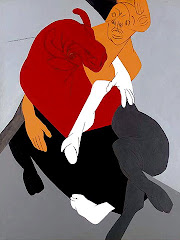Love and the Tao
Sometimes you find much the same idea occurs to people in both the West and the East. Consider first Heaney's poem, "Lovers On Aran":
The Timeless waves, bright shifting, broken glass,
Came dazling around, into the rocks,
Came glinting, sifting from the Americas
To possess Aran. Or did Aran rush
To throw wide arms of rock around a tide
That yielded with an ebb, with a soft crash?
Did sea define the land or land the sea?
Each drew new meaning from the waves collision,
Sea broke on land to full identity.
(- Seamus Heaney, Poems 1965-1975)
Now, compare Heaney to Lao-Tzu:
Being and non-being create each other.
Difficult and easy support each other.
Long and short define each other.
High and low depend on each other.
Before and after follow each other.
(Tao Te Ching, from Chapter 2, Stephen Mitchell trans.)
In Heaney's poem, we find much the same idea that contrasting things define each other as we do in Lao-Tzu.
Yet, perhaps there is this remarkable difference between Lao-Tzu and Heaney, between East and West: While Lao-Tzu implies that contrasting things are ultimately aspects of a single, undiferentiated, and ultimate reality, the Tao -- Heaney implies that it is love, rather than the Tao, which unites things.
After all, don't we in the West in many ways prefer to think of love as ultimate reality, rather than the impersonal Way?






 Stumble It!
Stumble It!





No comments:
Post a Comment